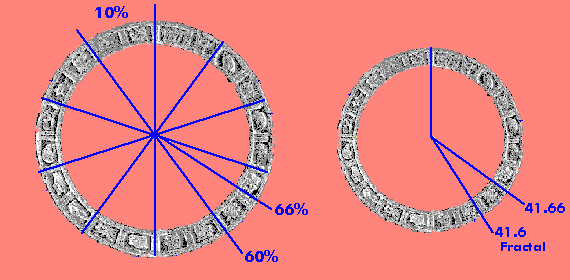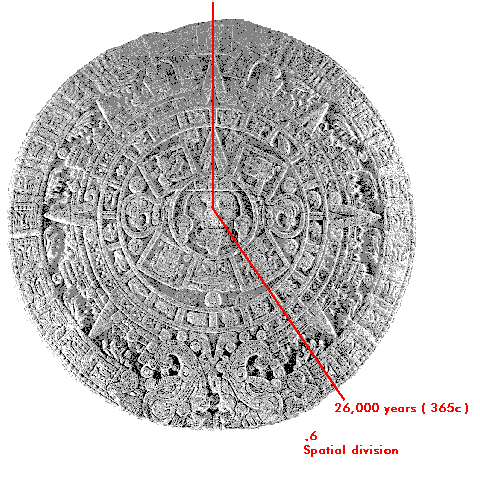THE RING OF FLAMES
Part Two
The figure of 41.6 complete calendars within the Sun's Great Cycle is significant, for it represents a fractal of the 416-year cycle that pertains to the 52:365c, as we have discussed in earlier essays (Earth/matrix Nos. 8 & 11).
To better exemplify the relevance of the 41.6 number, let us mark off where that value would fall on the Aztec Calendar itself. We do not have to show the 41 complete calendars, but rather must show where would the Aztec Calendar be divided by the line that would represent .6 (60 percent) of the Aztec Calendar's circular design of the 42nd calendar.
In order to divide the Aztec Calendar into ten equal segments, we may utilize the markings already devised on the day-glyph ring, marking off every two days, which would equal ten percent:
 |
As we can see from the above illustration, each day-glyph represents 5% of the calendar's circular design; two days thus represent 10%. Therefore, twelve days would represent the 60 percent that we are looking for from the 41.6 fractal. Now, let us mark off the .6 figure on the face of the Aztec Calendar:
 |
It is well known that the ancient astronomers worked with whole cycles, and numbers that were rounded off. Today, the Sun's Great Cycle is known to be 25,800 years, and not the 26,000 years that the ancient astronomers sometimes worked with. Although, it is also known that the maya worked with a figure of 25956 years (Harleston). The significant point in working with the rounded off figure of 26000 years (365c) becomes more obvious with having calculated the values of the Ring of Flames.
The line that marks off six-tenths of the surface design of the Aztec Calendar, as shown in the previous illustration, ends just before the day-glyph acatl, which is in fact the 13th day-glyph on the day-glyph ring itself. This is extremely significant in our viewpoint.
The glyph that is represented at the top of the Aztec Calendar has been identified as being 13-acatl (or 13 reed). It has been said that 13-acatl represents the date that the Aztec Calendar was completed, in the sense of having been sculpted or made.
However, if the calculations assigned herein represent a faithful possibility of relating constant numbers and assigned values from the 52:365c reckoning system, then possibly the 13-acatl significance may vary. For it might not represent simply the completion of the Aztec Calendar sculpture as such, but might also represent the completion of the Sun's Great Cycle of 26000 years, and its renewal on 13-acatl, sometime into the future.
At one time, early on during the discovery of the Aztec Calendar, it was thought that the glyph 13-acatl sculpted on its uppermost section, meant the beginning of time, the Creation of the Universe. That meaning was abandoned in favor of simply believing that 13-acatl represented the making of the Aztec Calendar as a sculpture.
With the numerical calculations and symbolism examined herein, there may possibly be another way of interpreting the 13-acatl assignment. The 41.6 complete cycles of the Aztec Calendar as proposed in this essay, may be confirming in the sense of double checking the 13-acatl glyph and the .6 line showing the 13-acatl sign on the day-glyph ring itself. One confirms the other. Exactly what particular meaning this relationship may have can only be interpreted as of great significance. The relationship pointing out the possible 26000-year period as calculated on the Ring of Flames, would seem to suggest their having known without a doubt the existence of the Sun's Great Cycle and their relationship to it in time, that is, in cosmic time.
Part Three